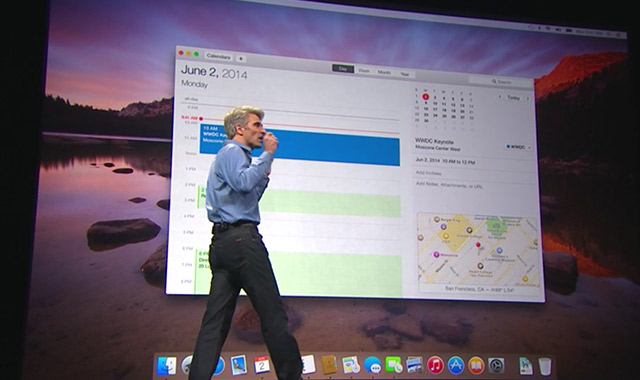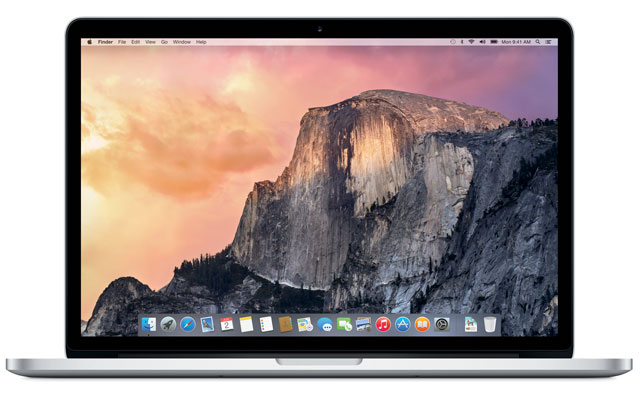
This year’s keynote at Apple’s Worldwide Developers Conference (WWDC) signalled a significant change of direction for the company. The new features announced for iOS 8 and Mac OS X 10.10 (Yosemite) point to much tighter integration between Apple devices, enhancing the experience for users who own more than one of the company’s products.
WWDC spans four days and is used to introduce Apple’s latest software and technologies to developers. Most of the topics discussed at the event are subject to strict non-disclosure rules, but the public keynote introduces the big picture in Apple software for the year ahead.
Senior vice-president of software engineering Craig Federighi used the keynote to debut Yosemite, which introduces a number of highly requested and much needed new features to Apple’s desktop platform. He also unveiled iOS 8, the upcoming version of the software that powers the iPad and the iPhone, which now offers tighter integration with Mac OS X.
Yosemite, which will be free for download when it is released later this year, has a number of features that allow greater interoperability between the iPhone, the iPad, and Mac laptops and desktops. The company will make Yosemite available as a public beta, the first time it’s done this. The beta programme will launch soon, said Federighi.
New typeface
Yosemite will introduce a host of changes to the familiar Mac interface. Its iconography more closely resembles iOS, and there is a new typeface, which creates a cleaner look and feel.
Apple has also made enhancements to AirDrop, allowing files to be transferred between Apple’s mobile devices and the Mac range.
It introduced a new Handoff feature, which allows users to start an e-mail on their iPhone and then pick it up, say, on their iPad, provided the devices are nearby.

Handoff knows when users’ devices are near so they can share documents, photos and even phone calls. Users can transfer calls from their iPhone to their Mac or iPad and the other way around. Federighi said the Mac can now be used as a speakerphone for the iPhone, and calls can be answered even if the user’s iPhone is not within reach.
Other notable additions to Mac OS X include a new dark mode or dark theme, enhanced Spotlight search features and a better notification centre that can use third-party widgets.
Both Mac OS X and iOS are getting an improved iMessage instant messaging application, with synchronisation of messages between devices. Apple also plans to offer audio and video messages via iMessage, borrowing ideas from rival WhatsApp’s playbook.
In iOS 8, Apple will place a strong emphasis on health care with an app called Health, which allows users to monitor a number of health metrics and can aggregate the data from a number of third-party health and fitness apps.
Prior to this year’s developer conference, rumours were rife about a possible play by Apple in home automation. Indeed, the company announced HomeKit, a smart home “protocol” that will allow Apple users to control and interact with a number of home automation devices using the iPhone with Siri voice commands. More than a dozen third-party companies have signed up to build hardware for HomeKit. Apple didn’t reveal more details.
Swiftly does it
Perhaps the most significant — and unexpected — announcement at this year’s WWDC was the fact that Apple is readying a new programming language called Swift. It’s the first new programming language that Apple has introduced since Objective C and Cocoa came to Apple via its acquisition of Steve Jobs’s NeXT in 1997.
Swift allows developers to build apps more quickly thanks to an interactive interface catering to modern Apple devices.

Apple is also making a more aggressive play in cloud computing to try to catch up with rival services from Dropbox, Microsoft and Google. Yosemite will introduce iCloud Drive, which will turn Apple’s existing online storage service into a fully fledged backup solution that offers improved cross-device synchronisation. It will work on Windows, too.
Pricing for iCloud Drive is on a par with other cloud storage and backup solutions. Apple will provide 20GB of cloud storage for US$0,99/month and 200GB for $3,99/month. Options of up to 1TB will be available.
iCloud Drive users will still receive 5GB of free storage space by default.
This year’s WWDC keynote has paved the way for Apple’s hardware announcements — new computers, iPads and iPhones — expected later this year.
It is evident that with the new mobile and desktop operating systems, Apple intends to solidify the user experience across its devices in a move clearly aimed at keeping consumers within its ecosystem. — © 2014 NewsCentral Media




